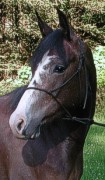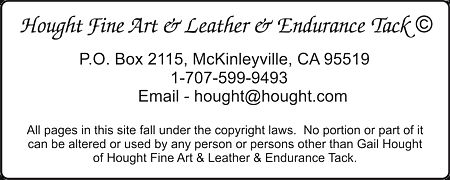|
Art Gallery (Horse Art) |
|
|
|
|
|
||
|
5/1/04 Maverick has 27 rides and 127 miles completed. Ninety to ninety five percent of those miles were at the walk. The emphasis has been on foot control, face, body suppleness, speed control and self confidence. It is important to walk this much for a couple reasons. Everything is relaxed and slow so he can think about and find the correct answer easily. He is finding the answer often early in preparation which tells me he does many things naturally. I will keep him quiet, relaxed and help him to increasingly find the correct answer. As he finds the correct answer sooner, it becomes easier and the repetition grows farther apart. His self confidence is steadily growing. When he executes the correct answer more than half the time, the repetition will lessen with a check here or there to test his retention. Once he is finding the correct answer consistently it usually means he is hearing the cue at a very low volume. No hurry. Walking the miles slowly develops his leg condition with little to no stress. His attitude remains great. His ears are always up, he is always looking around enjoying the ride and his trail skills, walk overs and water obstacles, are steadily growing. The foot patterns are steadily improving also. The first pattern is to walk a tight circle, about 10-12 feet in diameter, tracking up behind. Caution: Pay close attention he is tracking upn behind. If not, the rear feet stop, the fronts continue and the back drops or hollowas out. Pilot error! Keep him squeezed up so the back stays up or rounded. Now, this is important. He must be on the arc of the circle from nose to tail. The back is up and the front feet are traveling a larger circle than the back feet. A common mistake us for the horse to fall into the circle. Pilot error! Mechanically the inside shoulder will drop, remember the shoulders must remain levesl. Once he falls into it, shoulders are unlevel, feet stop moving, body arc changes, he hollows out and suppleness in the face stops. His spine from pole to tail is on the arc of the circle. If any part of him is off the arc, help him to be correct. Push with a leg, rein or ask with a direct rein. Don't lean your centerline off his centerline making sure to release when he is aligned. Your inside hand, holding the rein, should be held out to the side for him to see. This functions as another cue for the horse. Eventually he will begin turning when he sees your hand. Slowly his and your feel will become more sensitive and his correct execution of the foot pattern will improve. As his execution and feel develop, your inside hand will slowly move over the horn and the indirect rein will become more dominate than the direct rein. Yes, it's the beginning of neck reining. Usually the only time I use my outside foot is to encourage momentum. Make it as easy as possible for him to be successful. The diameter of this circle depends how tightly the horse can walk on a light, direct rein. Too small of a circle too soon is not good. You will probably resort to pulling too much to execute the circle. He should be relaxed and softly following his nose on the circle. I don't allow him to establish a pivot foot on this circle because it is important to keep his feet moving so they don't get tangled up AND to re-enforce momentum in the circle. A friend who bred and raised Maverick was
having difficulties understanding the description of the second
foot pattern. Her input was helpful and it goes like this. The
second foot pattern starts by closing the front door. Initially
closing the front door is followed by asking for one or two steps
laterally of the front feet which may be all he can accomplish
early in the preparation process. That's OK, reward every try.
Be satisfied with a step or two, that's success. Eventually his
nose will follow the arc, close the front door, the outside door
and open the inside door. He establishes an inside pivot foot,
rocks back and over that hind foot and the front feet step cross,
step cross to the inside until he has completed as much as 90,
180, 270 degrees etc. Maverick is doing so well it is difficult not to override him. No pressure is put on him, just repetition at times when it seemingly has no apparent meaning. Its just something we do. Let him execute correctly and become a habit. It would be easy for one to misunderstand or misinterpret pressure for work. Pressure says it has to be exactly like this. Work is if he executes poorly, we just do it again to get closer to correct. Remember, always reward any try. The reward is most always the release. Sometimes it is a rub on the neck or hip. He just executes and we continue down the trail. If he executes poorly, we go a few feet down the trail and try it again. No pressure, no problem. The cues are subtle and the volume is raised from time to time only as needed. The volume always starts low and increases until he hears the cue. Once he hears it, stop volume increase. It would be easy to over ride and expect him to execute with more precision. Too often we get into trouble by expecting more accurate execution too soon. Let it become something we just do and walk on down the trail. No pressure. The greatest advantage of the riding area I use is that it doesn't get boring for me or the horse because I am not in an arena. The shortest ride is about an hour and fifteen minutes or 3.3 miles. That is a long time in an arena setting to walk along trying this or that. It is also difficult to wait for the horse to accomplish a maneuver in an arena setting. It is very common to loose patience and wait for accomplishment of a specific move, so the rider goes to a larger bit, tying him around, back or jerking here or there. Anytime you can get out of the arena into a different setting will give you and your horse a mental break. Help him become successful. All these rides are lots of fun and I can't wait until the next. Keep It Simple. |
||

